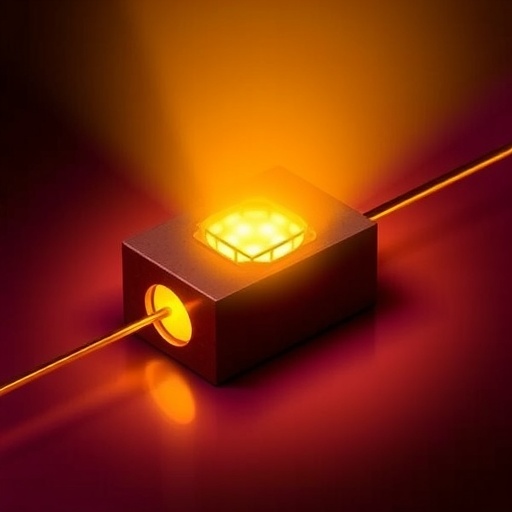In a groundbreaking advance for ultraviolet photon detection technology, researchers have developed a sophisticated numerical model to design Geiger-mode avalanche photodiodes (GM-APDs) with enhanced sensitivity in the near-ultraviolet (NUV) spectrum. GM-APDs are at the forefront of single-photon detection technology, capable of sensing individual photons with remarkable precision. These devices rely on the principle of impact ionization, where incident photons generate electron-hole pairs within the photodiode material, which under a high electric field, cascade into an avalanche of charges. This avalanche effect, triggered when the device operates above its breakdown voltage, results in a detectable electrical pulse signaling the arrival of a photon.
The new model specifically targets GM-APDs constructed from 4H-silicon carbide (4H-SiC), a semiconductor material known for its exceptional properties in detecting deep-ultraviolet (DUV) photons near 280 nanometers wavelength. However, as the wavelength increases into the NUV range, photon absorption weakens, compromising detection efficiency. To counter this, designers have historically attempted to increase absorber layer thickness, yet such a strategy introduces significant engineering complexities. The thickening of absorber layers necessitates a shift from traditional PIN photodiode architecture to more intricate separate-absorption charge-multiplication (SACM) architectures, presenting new challenges in device fabrication and performance optimization.
Led by Dr. Jonathan Schuster from the DEVCOM Army Research Laboratory, a team of researchers has formulated a calibrated 4H-SiC material library within their numerical framework, enabling precise simulation and strategy formulation for the enhancement of APD designs targeting higher wavelengths. The model allows exploration of both non-reach-through (NRT) and reach-through (RT) SACM architectures, each with distinct physical and operational characteristics. These simulations predict unity-gain quantum efficiencies (QE) — a critical metric indicating the ratio of photon absorption to generated electron-hole pairs without multiplication — of up to 32% for NRT-SACM and an impressive 71% for RT-SACM devices at 340 nm, well into the near-ultraviolet region.
Achieving high QE while maintaining necessary electric fields for avalanche multiplication requires meticulous doping and layer thickness controls. For NRT-SACM photodiodes, Dr. Schuster’s team elucidated the delicate balance between maximizing minority carrier diffusion length in the absorber layer and minimizing potential barriers at the absorber/charge layer interface. Such barriers can impede carrier transport, diminishing sensitivity. Conversely, in RT-SACM designs, optimizing the total charge within the charge layer ensures an electric field distribution that sustains avalanche breakdown while also supporting photon absorption within the absorber. This intricate engineering demonstrates the nuanced trade-offs in photodiode physics necessary for optimal single-photon detection.
The implications of this work extend far beyond design theory. The refined architectures and design rules illuminated by the numerical model pave the way for fabricating GM-APDs capable of reliably detecting photons in previously challenging wavelength regimes. These advancements are crucial for many applications reliant on UV photon detection, including solar-blind UV sensing, where detectors are blind to solar radiation wavelengths but sensitive to target signals, crucial for secure communication and environmental monitoring. Moreover, these devices have pivotal roles in combustion analysis and ultraviolet environmental sensors, sectors where performance and stability under harsh conditions are paramount.
Despite the promise, fabricating APDs based on the proposed SACM designs presents formidable challenges. The research highlights the inflexibility of charge layer designs to variations in thickness and doping concentrations, meaning precision in manufacturing is critical. This sensitivity underscores the necessity for advanced material synthesis and layer deposition techniques, a bottleneck in translating numerical designs into operational devices. Nonetheless, Dr. Schuster and colleagues’ work offers a roadmap for overcoming these barriers through judicious design parameter optimization guided by simulation insights.
Central to the developments is the broad wavelength response enabled by 4H-SiC’s wide bandgap. This material’s inherent properties make it resistant to high temperatures and radiation, suiting it for extreme environments where other semiconductors fail. The ability to tune these photodiodes effectively across the NUV spectrum means expanding the versatility of single-photon detection devices, unlocking potential in quantum communication, biological imaging, and astrophysical observations, where detecting faint ultraviolet signals is critical.
The numerical modeling methodology employed integrates comprehensive physical models of carrier transport, absorption coefficients, and impact ionization rates, all calibrated against empirical data. This ensures the simulations accurately reflect material behaviors under operational conditions. Such a calibrated approach is vital for predictive device design that minimizes costly trial-and-error fabrication cycles and accelerates innovation cycles in photonics and semiconductor device engineering.
Looking ahead, the team’s research not only charts a course toward new APD architectures but also sets a precedent for multidisciplinary approaches that blend materials science, quantum electronics, and computational physics. This synergy is necessary to confront the increasingly exacting demands of photon detection technologies, especially under the constraints imposed by quantum applications that require both speed and sensitivity.
In summary, the research spearheaded by Dr. Schuster addresses compelling design challenges inherent to enhancing NUV response in binary 4H-SiC SACM APDs. Through their innovative numerical model, they demonstrate the feasibility of high-efficiency, single-photon-sensitive detectors that overcome traditional limitations by carefully engineering doping profiles and layer structures. The results promise a surge in the utility and application of UV photodetection technologies, with ramifications for space exploration, defense, environmental science, and quantum information systems.
As the demand for sensitive ultraviolet photon detection rises, this work represents a crucial technological leap, harnessing the unique properties of silicon carbide and state-of-the-art computational modeling. The nuanced design principles elucidated here will empower engineers and scientists to push the boundaries of photodetection capabilities, enabling new discoveries and applications that depend on capturing photons that were previously lost to inefficiency and noise.
The reported advances in SACM APD architectures for NUV detection underscore the importance of fundamental materials research combined with innovative device engineering. They highlight a new frontier in photonics where precision at the atomic scale directly translates into groundbreaking innovations with broad societal impacts, from secure communications to environmental stewardship and beyond.
Article Title: Design Challenges in Binary 4H-SiC NUV-Enhanced SACM APDs
News Publication Date: 23-Jul-2025
Web References: http://dx.doi.org/10.1109/JQE.2025.3591762
Image Credits: Radovan Blažek at Openverse
Keywords
Physics, Particle Physics, Photons, Photodetection, Wavelengths, Wave Mechanics, Classical Mechanics, Engineering, Electronics, Electrical Engineering




